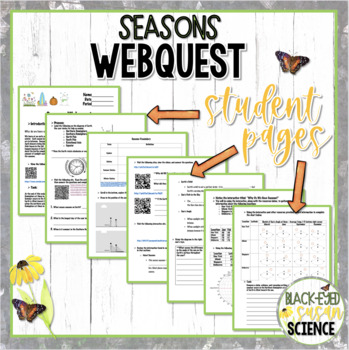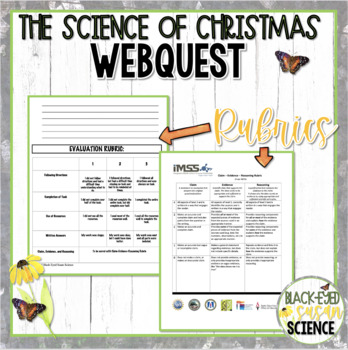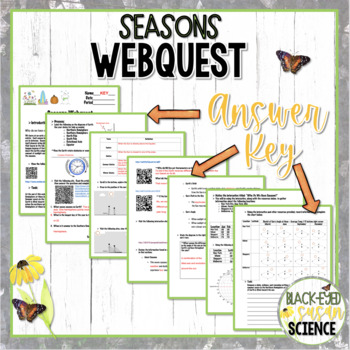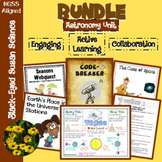Seasons Webquest (NGSS Aligned) MS-ESS1-1
- Zip
- Internet Activities
- Webquests
What educators are saying
Also included in
- 30% OFF!!!These resources will aid you in teaching Next Generation Science Standards MS-ESS1. Please take some to time look over all of the resources you will receive. They range from stations, a code-breaker challenge, hands-on activities, to doodle notes.Thank you for visiting Black-Eyed Susan SPrice $86.10Original Price $123.00Save $36.90
- Enjoy all of my WebQuests at 30% off!!!Please look at each product description for details.Thank you for visiting Black-Eyed Susan Science!!!Price $87.50Original Price $125.00Save $37.50
Description
This engaging, exciting, and rigorous WebQuest can be completed individually, with partners, or in groups. The purpose of this WebQuest is for students to learn how the tilt of the Earth’s axis, combined with Earth’s orbit, causes seasons. This activity guides students through exploring information, examples, videos, and interactives about Earth’s seasons. As the final task, students write a Claim, Evidence, Reasoning paragraph using the information they have gathered.
INTERESTED IN THE GOOGLE APPS VERSION?
Related Products
NGSS Aligned
MS-ESS1-1 Earth's Place in the Universe Students who demonstrate understanding can:
MS-ESS1-1. Develop and use a model of the Earth-sun-moon system to describe the cyclic patterns of lunar phases, eclipses of the sun and moon, and seasons. [Clarification Statement: Examples of models can be physical, graphical, or conceptual.]
The performance expectation above was developed using the following elements from the NRC document A Framework for K-12 Science Education: Science and Engineering Practices Developing and Using Models Modeling in 6–8 builds on K–5 experiences and progresses to developing, using, and revising models to describe, test, and predict more abstract phenomena and design systems.
Develop and use a model to describe phenomena.
Disciplinary Core Ideas ESS1.A: The Universe and Its Stars
Patterns of the apparent motion of the sun, the moon, and stars in the sky can be observed, described, predicted, and explained with models.
ESS1.B: Earth and the Solar System
This model of the solar system can explain eclipses of the sun and the moon. Earth’s spin axis is fixed in direction over the short-term but tilted relative to its orbit around the sun. The seasons are a result of that tilt and are caused by the differential intensity of sunlight on different areas of Earth across the year.
Crosscutting Concepts Patterns
Patterns can be used to identify cause-and-effect relationships.
- Connections to Nature of Science Scientific Knowledge Assumes an Order and Consistency in Natural Systems
Science assumes that objects and events in natural systems occur in consistent patterns that are understandable through measurement and observation.
Activity Focuses on Season Evidence Statements:
iii. Seasons:
1. Because the Earth’s axis is tilted, the most direct and intense solar energy occurs over the summer months, and the least direct and intense solar energy occurs over the winter months.
2. The change in season at a given place on Earth is directly related to the orientation of the tilted Earth and the position of Earth in its orbit around the sun because of the change in the directness and intensity of the solar energy at that place over the course of the year.
a. Summer occurs in the Northern Hemisphere at times in the Earth’s orbit when the northern axis of Earth is tilted toward the sun. Summer occurs in the Southern Hemisphere at times in the Earth’s orbit when the southern axis of Earth is tilted toward the sun.
b. Winter occurs in the Northern Hemisphere at times in the Earth’s orbit when the northern axis of Earth is tilted away from the sun. Summer occurs in the Southern Hemisphere at times in the Earth’s orbit when the southern axis of Earth is tilted away from the sun.
You may also be interested in:
Related Products
⭐ Astronomy Bundle NGSS MS-ESS1
⭐ Earth's Rotation & Revolution Squiggle Sheets & Understanding Checkpoint (NGSS)
⭐ Earth's Rotation and Revolution Squiggle Sheets---POWER POINT
⭐ Earth's Spheres Webquest (Geosphere, biosphere, hydrosphere, atmosphere) NGSS
⭐ Earth-sun-moon System Performance Assessment NGSS
⭐ Earth’s Place in the Universe Stations NGSS MS-ESS1-1 - ESS1-4
⭐ Eclipse Squiggle Sheets & Understanding Checkpoint (quiz) NGSS
⭐ Eclipse Squiggle Sheets---POWER POINT
⭐ Force Fields Webquest [Magnetism (NGSS Aligned)]
⭐ Gravity In Space Squiggle Sheets---POWER POINT
⭐ Gravity Squiggle Sheets & Understanding Checkpoint (Quiz) (NGSS Aligned)
⭐ Gravity Squiggle Sheets---POWER POINT
⭐ Gravity in Space Squiggle Sheets & Understanding Checkpoint NGSS MS-ESS1-2
⭐ Mass vs Weight Squiggle Sheets & Understanding Checkpoint (quiz)
⭐ Mass vs Weight Squiggle Sheets---POWER POINT
⭐ My Place in Space--Guided Notes MiniBook NGSS
⭐ NGSS Vocabulary KIMS Notes MS-ESS1-1
⭐ NGSS Vocabulary KIMS Notes MS-ESS1-2
⭐ Phases of the Moon Squiggle Sheets & Understanding Checkpoint (quiz) [NGSS]
⭐ Phases of the Moon Squiggle Sheets---POWER POINT
⭐ Space Observation, Inference, and Prediction
⭐ Space Squiggle Sheets Bundle
⭐ Stars and the Solar System Webquest NGSS 5 ESS1 (Earth's Place in the Universe)
⭐ The Case of Gravitational Interactions (NGSS MS-PS2-4)
⭐ The Case of Rotation & Revolution (NGSS)
⭐ The Case of Space (NGSS Aligned) [creating a scale model of solar system]
⭐ The Case of Space Exploration (NGSS Aligned)
⭐ The Case of the Invisible Force Fields (NGSS)
⭐ The Earth System (Earth's Spheres) Squiggle Sheets & Understanding Checkpoint
⭐ The Earth System (Earth's Spheres) Squiggle Sheets (NGSS)-POWER POINT
⭐ Three Truths and a Lie (Vocabulary) NGSS MS-ESS1-2
⭐ Three Truths and a Lie (Vocabulary) NGSS MS-ESS1-1
⭐ Seasons Squiggle Sheets---POWER POINT
⭐ Seasons Webquest (NGSS Aligned) MS-ESS1-1
⭐ Seasons Squiggle Sheets & Understanding Checkpoint (Quiz) NGSS Aligned
⭐ Tides Squiggle Sheets & Understanding Checkpoint (Quiz) NGSS Aligned
⭐ Tides Squiggle Sheets---POWER POINTS
Thank you for visiting Black-Eyed Susan Science.
Customer Tips:
Get TPT credit to use on future purchases:
- Please go to your My Purchases page (be sure you are logged in). At the top of the page you'll see a box and the message “Give feedback on recent purchases”. Simply click the “GIVE FEEDBACK” button and you will be taken to a page where you can give a quick rating and leave a comment for the product. I highly value your feedback. It helps me to make resources that meet your needs.
- Also, be the first to know about new resources, freebies, and sales - just click the green star at the top of the page next to the Black-Eyed Susan Science logo. You will then receive customized email updates about my new products.







